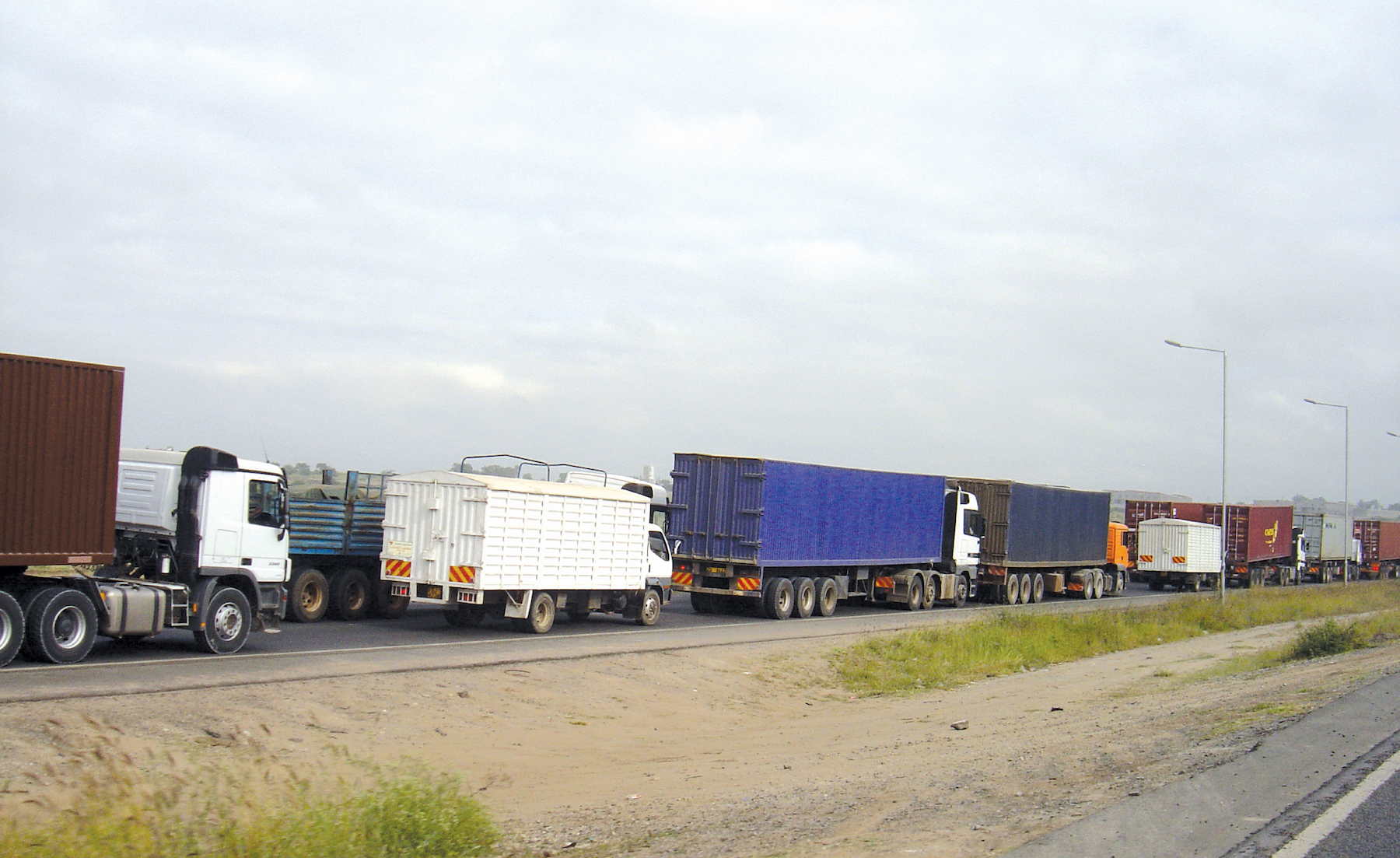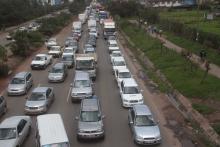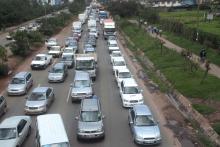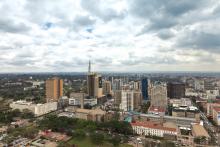New double deck roads could cut congestion in Kenyan capital Nairobi – Shem Oirere reports Arapid increase in urban population and diminishing land for infrastructure expansion has forced Kenya to devise ways of addressing the worsening human and vehicular traffic problems in its capital Nairobi. The country national highways agency recently announced progress in the planned construction of the country’s first double-decker highway.

These trucks on Mombasa Road, were captured waiting for their turn to make it to Nairobi’s Central Business District (CBD) passing through Uhuru Highway on their way to western Kenya, Uganda and Rwanda.
Photo: Shem Oirere
New double deck roads could cut congestion in Kenyan capital Nairobi – Shem Oirere reports
Arapid increase in urban population and diminishing land for infrastructure expansion has forced Kenya to devise ways of addressing the worsening human and vehicular traffic problems in its capital Nairobi. The country national Highways Agency recently announced progress in the planned construction of the country’s first double-decker highway.
2639 Kenya National Highways Authority (KeNHA) has invited bids for the construction of an elevated dual two-lane 4.5-6.5km road between Haile Selassie, Kenyatta and University Way roundabouts with the Central Business District (CBD).
KeNHA Director General Meshack Kidenda said construction of the double-decker road, part of a larger Nairobi city road expansion project, will start at any time and will involve the section between St James Hospital and James Gichuru roads/roundabouts. He confirmed the World Bank has provided more than US$200 million for the project.
The design by Danish firm2349 COWI and its Kenyan partner Otieno Odongo and Partners shows that this deck will have shoulders 0.5m wide to provide clearance to a 0.5m wide concrete median barrier and outshoulders 2.5m wide to accommodate broken down vehicles. The deck’s overall length will be 21.5m including the median barrier and 0.5m wide New Jersey type parapets.
This stretch of the highway will have 8m wide continuously reinforced concrete pavement (CRCP) carriageway for Bus Rapid Transit to cater for the Nairobi bus-based mass transit system buses. The BRT will be provided between pairs of pier columns which will sit to the inner side of a 4m wide island with New Jersey type barriers on the outer side to protect pedestrians.
The ground highway will have additional dual three-lane carriageway. Three new lanes will be added westwards of the existing road. The current centreline will be shifted westwards by one-and-half lanes.
The contractor will rehabilitate the existing southbound carriageway while BRT median lanes will continue straight in the elevated road and the “access ramps at either end will be uni-directional with the median in between.”
“Transition sections of the deck with varying widths will also be required at each end of the viaduct.”
COWI contract manager for the project Marcus Jon Wattam declined an interview to shed more light on the design because of what he said is “a confidentiality clause in our contract.” KeNHA Project Manager Denis Odeck is yet to respond to a request for additional details on this interesting project.
However, earlier, COWI’s project team leader Brian Segar was quoted telling reporters “the purposed design will get rid of roundabouts between Nyayo Stadium and Westlands which cause the most traffic congestion.”
This double-decker stretch is part of expansion of the 42km JKIA-Likoni-James Gichuru-Rironi road (A104). The project is also linked to the dual Airport South Road (3km), widening of JKIA access road (2km), construction of bitumen road to the proposed Barabara Plaza (2km) and construction of a 2km access road to the container terminal depot.
“One of the challenges for COWI's design team is to come up with an aesthetical solution that respects the need for increased traffic capacity as well as the pristine surroundings,” the designer says in one of its project briefings.
“In the design phase, COWI will not only take into consideration the city's surroundings but traffic simulations and analyses will also be used to ensure the city's traffic congestions will in fact be significantly reduced with the expansion of the highway.”
An international study by IBM last year ranked Nairobi the fourth most gruelling city in terms of traffic jams globally.
“Perhaps what’s behind these jams are the sheer number of cars on the road. Commuters in Nairobi (71 per cent) came in with the second highest percentages of drivers who drive a car alone to work — superseded by 76% of commuters in Johannesburg who reported that they do the same,” said Anthony Mwai, the country general manager,5366 IBM East Africa, during the release of the study findings. He said the figure is far much higher than the world’s average of 55%.
Director of intelligent transportation systems at IBM Vinodh Swaminathan said “In order to improve traffic flow and congestion, cities need to move beyond knowing and reacting; they have to find ways to anticipate and avoid situations that cause congestion that could turn the world into one giant parking lot.”
Nairobi deputy governor Jonathan Mueke says the Kenyan economy loses $219 million annually to traffic chaos in the capital in terms of low productivity, fuel consumption and pollution.
The Nairobi city highway project, initially part of Nairobi Toll road project, is Kenya’s solution to avert turning East Africa’s largest capital “into one giant parking lot.”
In the JKIA-Likoni-James Gichuru-Rironi road (A104) stretch construction works will include rehabilitation of the existing carriageway and constructing additional lanes such as two lanes on either side from JKIA to Nyayo Stadium, an elevated two-lane roadway on either side from Nyayo Stadium to Museum Hill roundabout, two lanes from Museum Hill roundabout to Uthiru and one lane on either side from Uthiru to Rironi.
This is the second time the World Bank is getting involved in road expansion in Kenya’s capital after its controversial withdrawal from the Nairobi Toll Road project which had been awarded on a 30-year concessional basis to945 Strabag AG and Israel’s Housing and Construction Holding Company joint venture. The joint venture was to design, construct, finance, and operate a 106km section of the toll road.
However, the project collapsed after the World Bank expressed reservations on one of the two companies and pulled out.
Arapid increase in urban population and diminishing land for infrastructure expansion has forced Kenya to devise ways of addressing the worsening human and vehicular traffic problems in its capital Nairobi. The country national Highways Agency recently announced progress in the planned construction of the country’s first double-decker highway.
KeNHA Director General Meshack Kidenda said construction of the double-decker road, part of a larger Nairobi city road expansion project, will start at any time and will involve the section between St James Hospital and James Gichuru roads/roundabouts. He confirmed the World Bank has provided more than US$200 million for the project.
The design by Danish firm
This stretch of the highway will have 8m wide continuously reinforced concrete pavement (CRCP) carriageway for Bus Rapid Transit to cater for the Nairobi bus-based mass transit system buses. The BRT will be provided between pairs of pier columns which will sit to the inner side of a 4m wide island with New Jersey type barriers on the outer side to protect pedestrians.
The ground highway will have additional dual three-lane carriageway. Three new lanes will be added westwards of the existing road. The current centreline will be shifted westwards by one-and-half lanes.
The contractor will rehabilitate the existing southbound carriageway while BRT median lanes will continue straight in the elevated road and the “access ramps at either end will be uni-directional with the median in between.”
“Transition sections of the deck with varying widths will also be required at each end of the viaduct.”
COWI contract manager for the project Marcus Jon Wattam declined an interview to shed more light on the design because of what he said is “a confidentiality clause in our contract.” KeNHA Project Manager Denis Odeck is yet to respond to a request for additional details on this interesting project.
However, earlier, COWI’s project team leader Brian Segar was quoted telling reporters “the purposed design will get rid of roundabouts between Nyayo Stadium and Westlands which cause the most traffic congestion.”
This double-decker stretch is part of expansion of the 42km JKIA-Likoni-James Gichuru-Rironi road (A104). The project is also linked to the dual Airport South Road (3km), widening of JKIA access road (2km), construction of bitumen road to the proposed Barabara Plaza (2km) and construction of a 2km access road to the container terminal depot.
“One of the challenges for COWI's design team is to come up with an aesthetical solution that respects the need for increased traffic capacity as well as the pristine surroundings,” the designer says in one of its project briefings.
“In the design phase, COWI will not only take into consideration the city's surroundings but traffic simulations and analyses will also be used to ensure the city's traffic congestions will in fact be significantly reduced with the expansion of the highway.”
An international study by IBM last year ranked Nairobi the fourth most gruelling city in terms of traffic jams globally.
“Perhaps what’s behind these jams are the sheer number of cars on the road. Commuters in Nairobi (71 per cent) came in with the second highest percentages of drivers who drive a car alone to work — superseded by 76% of commuters in Johannesburg who reported that they do the same,” said Anthony Mwai, the country general manager,
Director of intelligent transportation systems at IBM Vinodh Swaminathan said “In order to improve traffic flow and congestion, cities need to move beyond knowing and reacting; they have to find ways to anticipate and avoid situations that cause congestion that could turn the world into one giant parking lot.”
Nairobi deputy governor Jonathan Mueke says the Kenyan economy loses $219 million annually to traffic chaos in the capital in terms of low productivity, fuel consumption and pollution.
The Nairobi city highway project, initially part of Nairobi Toll road project, is Kenya’s solution to avert turning East Africa’s largest capital “into one giant parking lot.”
In the JKIA-Likoni-James Gichuru-Rironi road (A104) stretch construction works will include rehabilitation of the existing carriageway and constructing additional lanes such as two lanes on either side from JKIA to Nyayo Stadium, an elevated two-lane roadway on either side from Nyayo Stadium to Museum Hill roundabout, two lanes from Museum Hill roundabout to Uthiru and one lane on either side from Uthiru to Rironi.
This is the second time the World Bank is getting involved in road expansion in Kenya’s capital after its controversial withdrawal from the Nairobi Toll Road project which had been awarded on a 30-year concessional basis to
However, the project collapsed after the World Bank expressed reservations on one of the two companies and pulled out.







